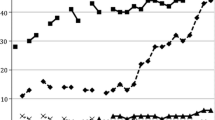Abstract
This article disaggregates change in adolescent fertility between 1971 and 1979 into four components: change in marriage patterns, in nonmarital sex, in pregnancy, and in birth. It also assesses quantitatively the relative contribution of each component to the change over time in two fertility outcomes: the probability of a nonmarital live birth and, given a live birth, the odds of its being nonmarital. The changes in the probability of sexual debut prior to marriage and in marriage patterns themselves are the two most important contributors to these changes. The influence on the change in adolescent fertility outcomes of the decreased likelihood of marriage following a nonmarital pregnancy was compensated for by the increased use of abortion to ter-minate the pregnancy.
Similar content being viewed by others
References
Aponte, R., K. M. Neckerman, and W. J. Wilson. 1985. Race, Family Structure, and Social Policy. Paper presented at the Colloquium on the Changing Situations of Black Americans and Women, University of Chicago, April 25–27.
Baldwin, W. H. 1980. Adolescent pregnancy and childbearing—Growing concerns for Americans. Population Bulletin 31:3–36.
Cutright, P. 1971. Illegitimacy: Myths, causes and cures. Family Planning Perspectives 3:25–48.
Davis, K., and J. Blake. 1956. Social structure and fertility: An analytic framework. Economic Development and Cultural Change 4:211–214.
Durand, J. D. 1948. The Labor Force in the United States: 1890–1960. New York: Social Science Research Council.
Ehrenreich, B., E. Hess, and G. Jacobs. 1986. Re-making Love: The Feminization of Sex. Garden City, N.Y.: Anchor Press/Doubleday.
Furstenberg, F., S. P. Morgan, K. A. Moore, and J. L. Peterson. 1987. Race differences in the timing of adolescent intercourse. American Sociological Review 52:511–518.
Gagnon, J. H., and W. Simon. 1973. Sexual Conduct: The Social Sources of Human Sexuality. Chicago: Aldine.
Goldscheider, F. K., and L. J. Waite. 1986. Sex differences in the entry into marriage. American Journal of Sociology 92:91–109.
Hayes, C. D. (ed.). 1987. Risking the Future: Adolescent Sexuality, Pregnancy, and Childbearing (Vol. 1). Washington, D.C.: National Academy Press.
Henshaw, S. K. 1987. Characteristics of U.S. women having abortions, 1982–1983. Family Planning Perspectives 19:5–9.
Henshaw, W. K., and K. O’Reilly. 1983. Characteristics of abortion patients in the United States, 1979 and 1980. Family Planning Perspectives 15:5–16.
Hofferth, S. L., and C. D. Hayes (eds.). 1987. Risking the Future: Adolescent Sexuality, Pregnancy, and Child-bearing (Vol. 2). Washington, D.C.: National Academy Press.
Hofferth, S. L., J. R. Kahn, and W. Baldwin. 1987. Premarital sexual activity among U.S. teenage women over the past three decades. Family Planning Perspectives 19:46–53.
Hogan, D. P., N. M. Astone, and E. M. Kitagawa. 1985. Social and environmental factors influencing contraceptive use among black adolescents. Family Planning Perspectives 17:165–169.
Hogan, D. P., and E. M. Kitagawa. 1985. The impact of social status, family structure, and neighborhood on the fertility of black adolescents. American Journal of Sociology 90:825–855.
Jones, E. F., J. D. Forrest, N. Goldman, S. K. Henshaw, R. Lincoln, J. I. Rosoff, C. F. Westoff, and D. Wulf. 1985. Teenage pregnancy in developed countries: Determinants and policy implications. Family Planning Perspectives 17:53–63.
Kim, Y. J., and D. M. Strobino. 1984. Decomposition of the difference between two rates with hierarchical factors. Demography 21:361–372.
Koenig, M., and M. Zelnik. 1982. The risk of premarital first pregnancy among metropolitan-area teenagers: 1976 and 1979. Family Planning Perspectives 14:239–247.
Luker, K. 1975. Taking Chances: Abortion and the Decision Not to Contracept. Berkeley: University of California Press.
Mosher, W. D., and C. A. Bachrach. 1987. First premarital contraceptive use: United States, 1960–82. Studies in Family Planning 18:83–95.
Murray, C. 1984. Losing Ground. New York: Basic Books.
National Center for Health Statistics. 1960–1969. Vital Statistics of the United States (Vol. 1): Natality (1960–1969). Hvattsville, Md.: Public Health Service.
—. 1974. Fertility Tables for Birth Cohorts by Color: United States, 1917–1973. Washington, D.C.: U.S. Government Printing Office. [DHEW Pub. No. (HRA) 76–1152.]
—. 1981. Advance Report of Final Natality Statistics, 1979, Monthly Vital Statistics Report, Vol. 30, No. 6 (Suppl.). Hvattsville, Md.: Public Health Service.
—. 1985. Advance Report of Final Natality Statistics, 1983, Monthly Vital Statistics Report, Vol. 34, No. 6 (Suppl.). Hvattsville, Md.: Public Health Service. [DHHS Pub. No. (PHS) 85–1120.)
O’Connell, M., and M. J. Moore. 1980. The legitimacy status of first births to U.S. women aged 15–24, 1939–1978. Family Planning Perspectives 12:16–25.
O’Connell, M., and C. C. Rogers. 1984. Out-of-wedlock births, premarital pregnancies and their effect on family formation and dissolution. Family Planning Perspectives 16:157–162.
Ventura, S. J. 1984. Trends in Teenage Childbearing, United States, 1970–1981, Vital and Health Statistics, Ser. 21, No. 41. Washington, D.C.: U.S. Government Printing Office. [DHHS Pub. No. (PHS) 84–1919.)
Waite, L. J., F. K. Goldscheider, and C. Witsberger. 1986. Nonfamily living and the erosion of traditional family orientations among young adults. American Sociological Review 51:541–554.
Wilson, W. J., and K. M. Neckerman. 1986. Poverty and family structure: The widening gap between evidence and public policy issues. In S. H. Danziger and D. H. Weinberg (eds.), Fighting Poverty: What Works and What Doesn’t. Cambridge, Mass.: Harvard University Press.
OZabin, L. 1981. The impact of early use of prescription contraceptives on reducing premarital teenage pregnancies. Family Planning Perspectives 13:72–74.
Zabin, L., J. F. Kantner, and M. Zelnik. 1979. The risk of adolescent pregnancy in the first months of intercourse. Family Planning Perspectives 11:215–225.
Zelnik, M., and J. F. Kantner. 1980. Sexual activity, contraceptive use and pregnancy among metropolitan-area teenagers: 1971–1979. Family Planning Perspectives 12:230–237.
Zelnik, M., J. F. Kantner, and K. Ford. 1981. Sex and Pregnancy in Adolescence. Beverly Hills, Calif: Sage.
Author information
Authors and Affiliations
Rights and permissions
About this article
Cite this article
Nathanson, C.A., Kim, Y.J. Components of change in adolescent fertility, 1971–1979. Demography 26, 85–98 (1989). https://doi.org/10.2307/2061496
Issue Date:
DOI: https://doi.org/10.2307/2061496




